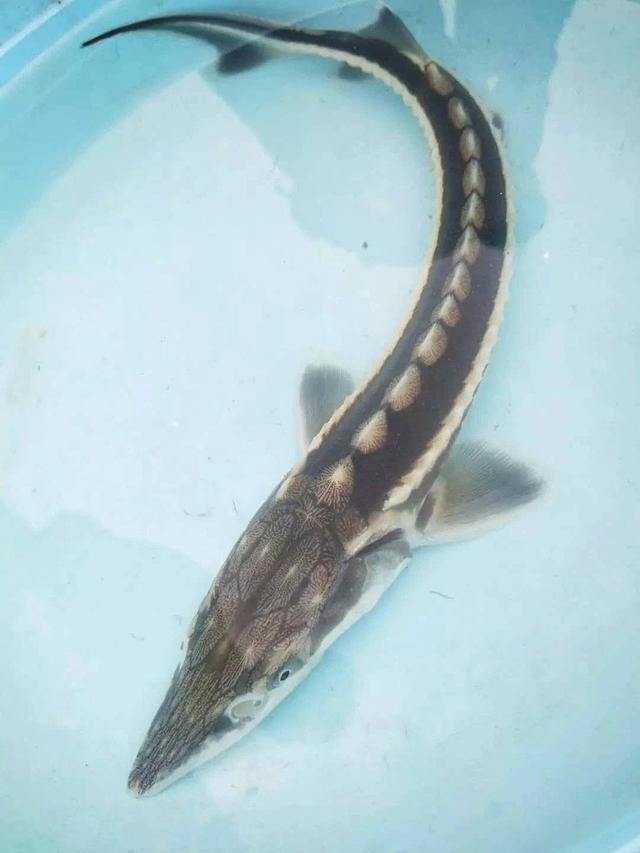Acipenser dabryanus is a type of sturgeon. It is one of the precious large fish species unique to my country, and its external morphology is similar to that of the Chinese sturgeon. It is one of the three types of sturgeons living in the Yangtze River (Acipenser dabryanus, Chinese sturgeon, and Chinese sturgeon).

Acipenser dabryanus is an ancient fish. As a member of the subclass of cartilaginous sclerophytes, many of its structures are relatively primitive among ray-finned fishes. The shovel-shaped snout is covered with ampullae of Lorentz, which allows them to sense the surrounding dynamics with electrical signals in the turbid river water. In their upturned tails, the caudal vertebrae go all the way to the upper lobe of the caudal fin, and the skin wrapped around it is covered with a layer of primitive and specialized hard scales. Inside the long fusiform body of Acipenser dabryanus, there is a special structure called "spiral valve" that helps the intestines digest food. Above the nitrification system is a white cartilage wrapped around the notochord. It is neither completely ossified like higher ray-finned fishes nor has calcium phosphate precipitation like cartilaginous fishes. It is like a tendon running through the fish body. Among all modern jawed fishes, this is almost the simplest and most primitive spinal structure.
Acipenser dabryanus was once one of the targets of fisheries in the main stream and main tributaries of the upper reaches of the Yangtze River. In the early 1970s, Acipenser dabryanus accounted for 4-10% of the total fishery output in Hejiang (Sichuan Yangtze River Fisheries Resources Survey Group, 1988). Since then, the resources of Acipenser dabryanus have dropped sharply. According to statistics, after the ban on fishing of Acipenser dabryanus in 1982, there was still a certain amount of bycatch in the upper reaches of the Yangtze River until 2000, but Acipenser dabryanus has not been found in the lower reaches of Gezhouba since 1994.
Three scientific fishing surveys were organized in the spring of 2002, spring of 2006 and winter in the Yibin area of Sichuan. Only one sturgeon weighing about 600 grams (total length 55 cm, body length 43 cm) was collected by mistake on May 7, 2002 in the Fuyan Town section of Pingshan.
The reasons for the depletion of sturgeon resources are multifaceted, mainly due to the destruction of juvenile fish resources and overfishing, but environmental pollution, channel regulation and sand dredging activities in the upper reaches of the Yangtze River are also causes that cannot be underestimated. Due to overfishing and pollution in the Yangtze River, the wild resources of Acipenser dabryanus have been severely damaged. In addition, the construction of the Gezhouba Dam and the Three Gorges Dam hydropower projects on the Yangtze River has blocked the passage for Acipenser dabryanus to migrate and spawn, which has had a great impact on the living environment of Acipenser dabryanus, causing a sharp decline in the natural population of Acipenser dabryanus. It is rare to catch individuals in the Yangtze River Basin.
As early as 1972, the Ministry of Agriculture of China issued two scientific research projects, "Survey of Yangtze River Aquatic Resources" and "Special Survey of Yangtze River Sturgeon", and wrote the book "Study on Biology and Artificial Propagation of Yangtze River Sturgeon", which systematically described the morphology, biology, ecology and resource status of Acipenser sinensis, Acipenser dabryanus and Yangtze sturgeon in the Yangtze River.
In 1976, Chongqing Fisheries Science Research Institute carried out artificial propagation of Acipenser dabryanus, and successfully induced the birth of mature Yangtze sturgeons caught in the river that year, obtaining more than 1,300 fry. Subsequently, the pond domestication and breeding research of Acipenser dabryanus was carried out, and the whole artificial propagation and domestication process from fertilized eggs to adult fish and then spawning was completed from 1976 to 1980 (Sichuan Yangtze River Fisheries Resources Survey Group, 1988).
In 2003, Sichuan Yibin Rare Animal Research Institute (private) conducted another artificial propagation experiment of Acipenser dabryanus, obtaining more than 120,000 fertilized eggs and about 20,000 fry. In April 2007, 2,000 Acipenser dabryanus with an average total length of 75 cm and a weight of 2.1 kg were released into the Yangtze River in Yibin. Before release, morphological identification and biological measurements were carried out, and 500 of them were multi-tagged.
In 2000, the first national nature reserve was established in the upper reaches of the Yangtze River. In 2002, a three-month seasonal fishing ban from February to April was implemented in the upper reaches of the Yangtze River. The area of the reserve was expanded in 2005 to reduce the conflict between hydropower projects and maintaining ecosystem functions.
In the early morning of April 4, 2022, during the patrol of the Jiang'an Yangtze River Patrol Team in Yibin, Sichuan, a national first-class protected animal weighing more than 10 kilograms, the Dabry's sturgeon, was rescued at the confluence of the Yujiang River and the Yangtze River on Binjiang Road.
Listed in the "IUCN Red List of Endangered Species" (IUCN 2009 ver 3.1) - Critically Endangered (CR).
Listed in the "Convention on International Trade in Endangered Species of Wild Fauna and Flora" (CITES) - Appendix II.
Listed in the "China National Key Aquatic Wildlife Protection Animals" (1998) - Level I.
Beijing time on July 21, 2022, the World Conservation Union updated the Red List of Endangered Species. The list shows that the Dabry's sturgeon is extinct in the wild.
Protect wild animals and stop eating game.
Maintaining ecological balance is everyone's responsibility!